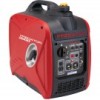Harbor Freight Tools 62523 User Manual - Page 18
Troubleshooting
 |
View all Harbor Freight Tools 62523 manuals
Add to My Manuals
Save this manual to your list of manuals |
Page 18 highlights
Safety Setup Troubleshooting Problem Engine will not start Possible Causes Probable Solutions FUEL RELATED: 1. No fuel in tank or fuel valve closed. 2. Choke not in START position, cold engine. 3. Gasoline with more than 10% ethanol used. (E15, E20, E85, etc.) 4. Low quality or deteriorated, old gasoline. 5. Carburetor not primed. 6. Dirty fuel passageways. 7. Carburetor needle stuck. Fuel can be smelled in the air. 8. Too much fuel in chamber. This can be caused by the carburetor needle sticking. 9. Clogged Fuel Filter. IGNITION (SPARK) RELATED: 1. Spark plug cap not connected securely. 2. Spark plug electrode wet or dirty. 3. Incorrect spark plug gap. 4. Spark plug cap broken. 5. Incorrect spark timing or faulty ignition system. COMPRESSION RELATED: 1. Cylinder not lubricated. Problem after long storage periods. 2. Loose or broken spark plug. (Hissing noise will occur when trying to start.) 3. Loose cylinder head or damaged head gasket. (Hissing noise will occur when trying to start.) 4. Engine valves or tappets mis‑adjusted or stuck. FUEL RELATED: 1. Fill fuel tank with fresh 87+ octane stabilizer-treated unleaded gasoline and open fuel valve. Do not use gasoline with more than 10% ethanol (E15, E20, E85, etc.). 2. Move Choke to START position. 3. Clean out ethanol rich gasoline from fuel system. Replace components damaged by ethanol. Use fresh 87+ octane stabilizer-treated unleaded gasoline only. Do not use gasoline with more than 10% ethanol (E15, E20, E85, etc.). 4. Use fresh 87+ octane stabilizer-treated unleaded gasoline. Do not use gasoline with more than 10% ethanol (E15, E20, E85, etc.). 5. Pull on Starter Handle to prime. 6. Clean out passageways using fuel additive. Heavy deposits may require further cleaning. 7. Gently tap side of carburetor float chamber with screwdriver handle. 8. Turn Choke to RUN position. Remove spark plug and pull the start handle several times to air out the chamber. Reinstall spark plug and set Choke to START position. 9. Replace Fuel Filter. IGNITION (SPARK) RELATED: 1. Connect spark plug cap properly. 2. Clean spark plug. 3. Correct spark plug gap. 4. Replace spark plug cap. 5. Have qualified technician diagnose/ repair ignition system. COMPRESSION RELATED: 1. Pour tablespoon of oil into spark plug hole. Crank engine a few times and try to start again. 2. Tighten spark plug. If that does not work, replace spark plug. If problem persists, may have head gasket problem, see #3. 3. Tighten head. If that does not remedy problem, replace head gasket. 4. Have qualified technician adjust/ repair valves and tappets. ENGINE OIL RELATED: 1. Low engine oil. 2. Engine mounted on slope, triggering low oil shutdown. ENGINE OIL RELATED: 1. Fill engine oil to proper level. Check engine oil before EVERY use. 2. Operate engine on level surface. Check engine oil level. Follow all safety precautions whenever diagnosing or servicing the generator or engine. Operation Maintenance Page 18 For technical questions, please call 1-888-866-5797. ITEM 62523















